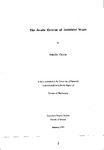The In-situ Erosion of Intertidal Muds
| dc.contributor.author | Christie, Malcolm | |
| dc.contributor.other | School of Biological and Marine Sciences | en_US |
| dc.date.accessioned | 2013-10-09T09:58:06Z | |
| dc.date.available | 2013-10-09T09:58:06Z | |
| dc.date.issued | 1997 | |
| dc.identifier | NOT AVAILABLE | en_US |
| dc.identifier.uri | http://hdl.handle.net/10026.1/2103 | |
| dc.description.abstract |
Intertidal mudflats can experience rapid morphological changes, and are both sources and sinks of fine cohesive sediment within an estuary. Successful environmental management of these regions depends upon in-situ measurements, which help specify the interactions between the active processes and so allow the development of predictive models that the management practices require. The Profiles of Sediment Transport system (POST) has been developed in order to make high frequency measurements of velocity and suspended sediment concentration profiles in very shallow water (i.e. when depth, h < 1.0 m). Electromagnetic current meters and optical sensors were miniaturised to allow measurements within a few centimetres of the sea bed and provide fine scale resolution of vertical profiles. Two in-situ experiments, located in the Severn and Humber estuaries, examined the response of a mudflat to changing environmental factors, and in particular, studied the influence of local waves and tidal currents in very shallow water of depth (h)< 1.0 m. A value of 0.127 Nmˉ²was considered to be representative of the critical erosion shear stress (Tint) at Portishead, while at Skeffling τait was estimated to be about 0.31 Nmˉ². The effects of wave and current action were quantified and expressions were used to describe the relationships between velocity, bed shear stress and concentration. An expression relating near bed concentration to mean velocity (U ) at Skeffling was simply: Concentration (gLˉ¹) = 1.908 U + 0.193 when h< 1.0 m. R² = 0.730 The physical processes causing erosion and deposition across two mudflats have been identified, and the predictive expressions are considered to provide first order approximations for sediment concentrations and transport behaviour, for similar conditions at other North European sites. The results showed that the shallow water periods at the beginning and end of tidal coverage were extremely important in determining the surface character of the mudflat, and any erosion was most marked at these times. Small waves can be crucial to erosion because of their large contribution to the bed shear stresses in shallow water. Ignoring biological and chemical variables (both of which can control of erosion), it is proposed that for typical temperate environmental conditions, some form of mudflat erosion is likely when h< 1.0 m, and either the significant wave height (H2) is greater than 0.25 m, or the near bed velocities exceed 0.2 msˉ¹. | en_US |
| dc.language.iso | en | en_US |
| dc.publisher | University of Plymouth | en_US |
| dc.title | The In-situ Erosion of Intertidal Muds | en_US |
| dc.type | Thesis | |
| plymouth.version | Full version | en_US |
| dc.identifier.doi | http://dx.doi.org/10.24382/3710 | |
| dc.identifier.doi | http://dx.doi.org/10.24382/3710 |
Files in this item
This item appears in the following Collection(s)
-
01 Research Theses Main Collection
Research Theses Main


